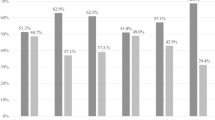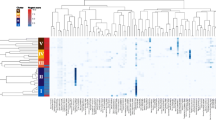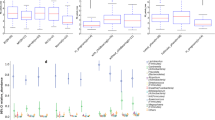Abstract
The female genital tract (FGT) harbors very large numbers of bacterial species that are known to play an important role on vaginal health. Previous studies have focused on bacterial diversity in the vagina, but little is known about the ectocervical microbiota associated with FGT infections. In our study, vaginal swabs and ectocervical swabs were collected from 100 participants in China, including 30 women with bacterial vaginosis (BV; BV group), 22 women with cervicitis (Cer group), 18 women with BV in combination with cervicitis (BC group) and 30 healthy control women (CN group). The diversity and richness of cervicovaginal microbiota were investigated with culture-independent polymerase chain reaction (PCR)-denaturing gradient gel electrophoresis (DGGE) and quantitative PCR (qPCR) targeting 11 microorganisms that have been associated with FGT infections. Despite significant interpersonal variations, the PCR-DGGE profiles revealed that vaginal microbiota and ectocervical microbiota were clearly much more complex in the BV group, while the ectocervical microbiota showed no significant difference between healthy and diseased participants. Using species-specific qPCR, BV and cervicitis were significantly associated with a dramatic decrease in Lactobacillus species (p < 0.05), and potential pathogenic species such as Gardnerella, Atopobium, Eggerthella, Leptotrichia/Sneathia, and Prevotella were more common and in higher copy numbers in BV than in CN samples (p values ranged from 0.000 to 0.021). No significant differences were observed between healthy and cervicitis samples (p > 0.05) in ectocervical microbiota. The total numbers of bacteria were significantly lower in the ectocervix as compared in the vagina (p < 0.05). Intriguingly, vaginal microbiota from participants with BV in combination with cervicitis was quite different from that of participants with BV or cervicitis alone. Our study demonstrated that the cervicovaginal microbiota was actively involved in the process of FGT infections. The predominant bacteria of the cervicovaginal communities were clearly associated with BV; however, there was not sufficient evidence that the ectocervical microbiota is directly involved in the development of cervicitis.


Similar content being viewed by others
References
Antonio MA, Hawes SE, Hillier SL (1999) The identification of vaginal Lactobacillus species and the demographic and microbiologic characteristics of women colonized by these species. J Infect Dis 180:1950–1956
Boskey ER, Cone RA, Whaley KJ, Moench TR (2001) Origins of vaginal acidity: high D/L lactate ratio is consistent with bacteria being the primary source. Hum Reprod 16:1809–1813
Redondo-Lopez V, Cook RL, Sobel JD (1990) Emerging role of Lactobacilli in the control and maintenance of the vaginal bacterial microflora. Rev Infect Dis 12:856–872
Zhou X, Brown CJ, Abdo Z, Davis CC, Hansmann MA, Joyce P, Foster JA, Forney LJ (2007) Differences in the composition of vaginal microbial communities found in healthy Caucasian and black women. ISME J 1:121–133
Fredricks DN, Fiedler TL, Marrazzo JM (2005) Molecular identification of bacteria associated with bacterial vaginosis. N Engl J Med 353:1899–1911
Dethlefsen L, McFall-Ngai M, Relman DA (2007) An ecological and evolutionary perspective on human-microbe mutualism and disease. Nature 449:811–818
Cole AM (2006) Innate host defense of human vaginal and cervical mucosae. Curr Top Microbiol Immunol 306:199–230
Kim TK, Thomas SM, Ho M, Sharma S, Reich CI, Frank JA, Yeater KM, Biggs DR, Nakamura N, Stumpf R, Leigh SR, Tapping RI, Blanke SR, Slauch JM, Gaskins HR, Weisbaum JS, Olsen GJ, Hoyer LL, Wilson BA (2009) Heterogeneity of vaginal microbial communities within individuals. J Clin Microbiol 47:1181–1189
Wang J (2000) Bacterial vaginosis. Prim Care Update Ob Gyns 7:181–185
Gaydos C, Maldeis NE, Hardick A, Hardick J, Quinn TC (2009) Mycoplasma genitalium as a contributor to the multiple etiologies of cervicitis in women attending sexually transmitted disease clinics. Sex Transm Dis 36:598–606
Schwebke JR (2009) New concepts in the etiology of bacterial vaginosis. Curr Infect Dis Rep 11:143–147
Kalra A, Palcu CT, Sobel JD, Akins RA (2007) Bacterial vaginosis: culture- and PCR-based characterizations of a complex polymicrobial disease’s pathobiology. Curr Infect Dis Rep 9:485–500
Schwebke JR (2000) Bacterial vaginosis. Curr Infect Dis Rep 2:14–17
Allsworth JE, Peipert JF (2007) Prevalence of bacterial vaginosis: 2001–2004 national health and nutrition examination survey data. Obstet Gynecol 109:114–120
Haggerty CL, Hillier SL, Bass DC, Ness RB (2004) Bacterial vaginosis and anaerobic bacteria are associated with endometritis. Clin Infect Dis 39:990–995
Sweet RL (1995) Role of bacterial vaginosis in pelvic inflammatory disease. Clin Infect Dis 20(Suppl 2):S271–S275
Gravett MG, Hummel D, Eschenbach DA, Holmes KK (1986) Preterm labor associated with subclinical amniotic fluid infection and with bacterial vaginosis. Obstet Gynecol 67:229–237
Hillier SL, Nugent RP, Eschenbach DA, Krohn MA, Gibbs RS, Martin DH, Cotch MF, Edelman R, Pastorek JG 2nd, Rao AV et al (1995) Association between bacterial vaginosis and preterm delivery of a low-birth-weight infant. The vaginal infections and prematurity study group. N Engl J Med 333:1737–1742
Ness RB, Kip KE, Hillier SL, Soper DE, Stamm CA, Sweet RL, Rice P, Richter HE (2005) A cluster analysis of bacterial vaginosis-associated microflora and pelvic inflammatory disease. Am J Epidemiol 162:585–590
Peipert JF, Montagno AB, Cooper AS, Sung CJ (1997) Bacterial vaginosis as a risk factor for upper genital tract infection. Am J Obstet Gynecol 177:1184–1187
Schwebke JR, Weiss HL (2002) Interrelationships of bacterial vaginosis and cervical inflammation. Sex Transm Dis 29:59–64
Cohen CR, Manhart LE, Bukusi EA, Astete S, Brunham RC, Holmes KK, Sinei SK, Bwayo JJ, Totten PA (2002) Association between Mycoplasma genitalium and acute endometritis. Lancet 359:765–766
Marrazzo JM, Celum CL, Hillis SD, Fine D, DeLisle S, Handsfield HH (1997) Performance and cost-effectiveness of selective screening criteria for Chlamydia trachomatis infection in women. Implications for a national Chlamydia control strategy. Sex Transm Dis 24:131–141
Brunham RC, Paavonen J, Stevens CE, Kiviat N, Kuo CC, Critchlow CW, Holmes KK (1984) Mucopurulent cervicitis—the ignored counterpart in women of urethritis in men. N Engl J Med 311:1–6
Nyirjesy P (2001) Nongonococcal and nonchlamydial cervicitis. Curr Infect Dis Rep 3:540–545
Marrazzo JM, Handsfield HH, Whittington WL (2002) Predicting chlamydial and gonococcal cervical infection: implications for management of cervicitis. Obstet Gynecol 100:579–584
Marrazzo JM, Wiesenfeld HC, Murray PJ, Busse B, Meyn L, Krohn M, Hillier SL (2006) Risk factors for cervicitis among women with bacterial vaginosis. J Infect Dis 193:617–624
Yoshimura K, Yoshimura M, Kobayashi T, Kubo T, Hachisuga T, Kashimura M (2009) Can bacterial vaginosis help to find sexually transmitted diseases, especially chlamydial cervicitis? Int J STD AIDS 20:108–111
Ling Z, Kong J, Liu F, Zhu H, Chen X, Wang Y, Li L, Nelson KE, Xia Y, Xiang C (2010) Molecular analysis of the diversity of vaginal microbiota associated with bacterial vaginosis. BMC Genomics 11:488
Amsel R, Totten PA, Spiegel CA, Chen KC, Eschenbach D, Holmes KK (1983) Nonspecific vaginitis. Diagnostic criteria and microbial and epidemiologic associations. Am J Med 74:14–22
Nugent RP, Krohn MA, Hillier SL (1991) Reliability of diagnosing bacterial vaginosis is improved by a standardized method of gram stain interpretation. J Clin Microbiol 29:297–301
Li M, Wang B, Zhang M, Rantalainen M, Wang S, Zhou H, Zhang Y, Shen J, Pang X, Zhang M, Wei H, Chen Y, Lu H, Zuo J, Su M, Qiu Y, Jia W, Xiao C, Smith LM, Yang S, Holmes E, Tang H, Zhao G, Nicholson JK, Li L, Zhao L (2008) Symbiotic gut microbes modulate human metabolic phenotypes. Proc Natl Acad Sci USA 105:2117–2122
Wei G, Lu H, Zhou Z, Xie H, Wang A, Nelson K, Zhao L (2007) The microbial community in the feces of the giant panda (Ailuropoda melanoleuca) as determined by PCR-TGGE profiling and clone library analysis. Microb Ecol 54:194–202
Ling Z, Kong J, Jia P, Wei C, Wang Y, Pan Z, Huang W, Li L, Chen H, Xiang C (2010) Analysis of oral microbiota in children with dental caries by PCR-DGGE and barcoded pyrosequencing. Microb Ecol 60:677–690
Muyzer G, de Waal EC, Uitterlinden AG (1993) Profiling of complex microbial populations by denaturing gradient gel electrophoresis analysis of polymerase chain reaction-amplified genes coding for 16S rRNA. Appl Environ Microbiol 59:695–700
Yu Z, Morrison M (2004) Comparisons of different hypervariable regions of rrs genes for use in fingerprinting of microbial communities by PCR-denaturing gradient gel electrophoresis. Appl Environ Microbiol 70:4800–4806
Lipp JS, Morono Y, Inagaki F, Hinrichs KU (2008) Significant contribution of Archaea to extant biomass in marine subsurface sediments. Nature 454:991–994
Heilig HG, Zoetendal EG, Vaughan EE, Marteau P, Akkermans AD, de Vos WM (2002) Molecular diversity of Lactobacillus spp. and other lactic acid bacteria in the human intestine as determined by specific amplification of 16S ribosomal DNA. Appl Environ Microbiol 68:114–123
Byun R, Nadkarni MA, Chhour KL, Martin FE, Jacques NA, Hunter N (2004) Quantitative analysis of diverse Lactobacillus species present in advanced dental caries. J Clin Microbiol 42:3128–3136
Tamrakar R, Yamada T, Furuta I, Cho K, Morikawa M, Yamada H, Sakuragi N, Minakami H (2007) Association between Lactobacillus species and bacterial vaginosis-related bacteria, and bacterial vaginosis scores in pregnant Japanese women. BMC Infect Dis 7:128
Zariffard MR, Saifuddin M, Sha BE, Spear GT (2002) Detection of bacterial vaginosis-related organisms by real-time PCR for Lactobacilli, Gardnerella vaginalis and Mycoplasma hominis. FEMS Immunol Med Microbiol 34:277–281
Ferris MJ, Masztal A, Martin DH (2004) Use of species-directed 16S rRNA gene PCR primers for detection of Atopobium vaginae in patients with bacterial vaginosis. J Clin Microbiol 42:5892–5894
Martin FE, Nadkarni MA, Jacques NA, Hunter N (2002) Quantitative microbiological study of human carious dentine by culture and real-time PCR: association of anaerobes with histopathological changes in chronic pulpitis. J Clin Microbiol 40:1698–1704
Fredricks DN, Relman DA (1999) Paraffin removal from tissue sections for digestion and PCR analysis. Biotechniques 26:198–200
Vitali B, Pugliese C, Biagi E, Candela M, Turroni S, Bellen G, Donders GG, Brigidi P (2007) Dynamics of vaginal bacterial communities in women developing bacterial vaginosis, candidiasis, or no infection, analyzed by PCR-denaturing gradient gel electrophoresis and real-time PCR. Appl Environ Microbiol 73:5731–5741
Menard JP, Fenollar F, Henry M, Bretelle F, Raoult D (2008) Molecular quantification of Gardnerella vaginalis and Atopobium vaginae loads to predict bacterial vaginosis. Clin Infect Dis 47:33–43
Ley RE, Knight R, Gordon JI (2007) The human microbiome: eliminating the biomedical/environmental dichotomy in microbial ecology. Environ Microbiol 9:3–4
Swidsinski A, Loening-Baucke V, Verstraelen H, Osowska S, Doerffel Y (2008) Biostructure of fecal microbiota in healthy subjects and patients with chronic idiopathic diarrhea. Gastroenterology 135:568–579
Bezirtzoglou E, Voidarou Ch, Papadaki A, Tsiotsias A, Kotsovolou O, Konstandi M (2008) Hormone therapy alters the composition of the vaginal microflora in ovariectomized rats. Microb Ecol 55:751–759
Gorodeski GI, Hopfer U, Liu CC, Margles E (2005) Estrogen acidifies vaginal pH by up-regulation of proton secretion via the apical membrane of vaginal-ectocervical epithelial cells. Endocrinology 146:816–824
Zozaya-Hinchliffe M, Lillis R, Martin DH, Ferris MJ (2010) Quantitative PCR assessments of bacterial species in women with and without bacterial vaginosis. J Clin Microbiol 48:1812–1819
Keshavarz H, Duffy SW, Sadeghi-Hassanabadi A, Zolghadr Z, Oboodi B (2001) Risk factors for and relationship between bacterial vaginosis and cervicitis in a high risk population for cervicitis in Southern Iran. Eur J Epidemiol 17:89–95
Acknowledgments
This present work was funded by grant no. 2007CB513001 from the National Basic Research Program of China (973 program) and partly supported by grants from China’s National Science and Technology Major Project (nos. 2008ZX10004-002 and 2009ZX10004-105), and a Qiu-Shi Professorship from Zhejiang University. We thank Dr. William C. Nierman from the J. Craig Venter Institute in Rockville, Maryland, USA for critical reading.
Author information
Authors and Affiliations
Corresponding authors
Rights and permissions
About this article
Cite this article
Ling, Z., Liu, X., Chen, X. et al. Diversity of Cervicovaginal Microbiota Associated with Female Lower Genital Tract Infections. Microb Ecol 61, 704–714 (2011). https://doi.org/10.1007/s00248-011-9813-z
Received:
Accepted:
Published:
Issue Date:
DOI: https://doi.org/10.1007/s00248-011-9813-z




